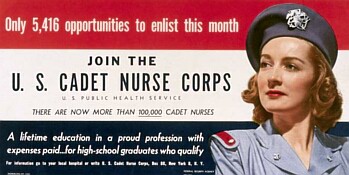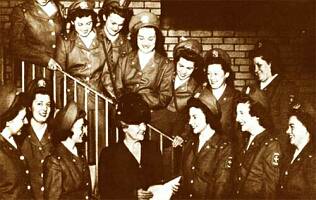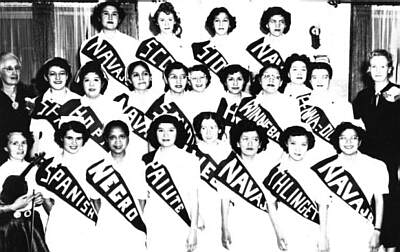|
|
| For the first year, the goal was to recruit
65,000 new student nurses, which represented about 10 percent of the high
school graduates in 1943. The success of the Cadet Nurse program was so
immense that the number of enrollments actually surpassed this quota for
the year 1943. The goal of recruiting additional 65,000 nurse students
in 1944 and another 60,000 in 1945 was also nearly fulfilled. During 1945,
85 % of nurse students in the country were Cadet Nurses.
. 
. . .
This and other factors caused a white backlash
against the program in segregated areas of the country. While preaching
freedom abroad, America always faced problems in social equality at home.
Soon after the end of war, the Federal government decided to stop the Cadet
Nurse Program in view of this public outcry, which was largely driven by
angry white voters in a few Southern states who were nevertheless politically
significant. The death of President Roosevelt eliminated the influence
of his distinguished wife to keep such a mixed-race program alive. No more
applicants were admitted after October 15, 1945. Currently enrolled Cadet
Nurses were allowed to complete their training. The Cadet Nurse Corps ended
in 1948 with the graduation of its last class of students. Nearly 170,000
students enrolled in the Cadet Nurse Corps; 124,065 of them graduated.

Francis Bolton surrounded by Cadet Nurses The Cadet Nurse program effectively produced emergency personnel capable of serving as acting nurse-substitutes during the war. The nurse students could not always remedy the shortage of qualified trained nurses needed in medical positions since the students lacked the knowledge and experience of actual graduated nurses. However, without the Cadet Nurse Corps many communities would not have had any medical care at all. Their service was an exceptionally valuable contribution to the United States during and following World War II.
Furthermore, the Cadet Nurse program led to significant improvements in nursing education. School facilities like classrooms, housing quarters and libraries of nursing schools were improved and enlarged across the country. Course offerings were expanded (for example in such fields as convalescent care, public health, pediatrics, tuberculosis, and psychiatric care) and faculty sizes increased. Additionally, the Corps prompted special attention and Federal aid to postgraduate studies for nurses. More women than ever before were able to attend university nursing schools through the Cadet Nurse Corps scholarships. The publicity surrounding the Cadet Nurse Corps and its successes enhanced the visibility of nursing in the country greatly. Perhaps one of the greatest accomplishments
was the important progressive social aspect of the Cadet Nurse Corps. The
bold opening of the program to minority women enabled them to gain employment
in a sector previously almost exclusively white beforehand.

Nurse's Gee Club representing different tribes and races Lucy Petry assigned the Black nurse Rita Miller to her staff. Ms. Miller chaired the Division of Nursing at the Dillard University in New Orleans, responsible for assisting Black schools to apply for participation in the Cadet Nurse Program. Generous grants were awarded to several Black nursing schools that showed increasing student enrollment. By the end of World War II, 49 schools of nurses had admitted Black students (in 1941, there were only 29 schools). Some of these schools were previously White-only schools that, under pressure from Mrs. Roosevelt and the federal government, abandoned their discriminatory policies and allowed mixed enrollments. The Cadet Nurse Corps enabled minority women their only chances to secure acceptance to such institutions previously closed to them.
The Cadet Nurse Corps neither was not a branch of the armed forces nor of the civilian personnel force of the United States government. Therefore, after the end of war, their contribution to the war effort as student trainees was not considered as federal service and they did not receive Veteran's status and Veteran's benefits. Contemporary racial prejudice also played an unfortunate part in denying them proper credit for their homeland contribution, because segregationists did not consider such Black nurses and Black nurse assistants deserving of such honor. In 2003, Rep. Nita Lowey introduced the U.S.
Cadet Nurse Corps Equity Act requesting to grant former members of the
Cadet Nurse Corps full veteran status. She and many others assess this
status as justified because Cadet Nurses were enlisted in a uniformed military-type
service in a time of war under the command of the United States Public
Health Service and the Surgeon General of the United States.
|

| [Homepage] |